Many tools help project managers deliver their projects. One is the impact effort matrix, which we’ll define shortly. This visual tool is handy when deciding how to allocate resources to maximize their effectiveness.
Read on to learn when to use an effort impact matrix and why it benefits project management. We’ll also provide a free download for an impact effort matrix template and show how to make one from scratch to better understand how it works and its value.
What Is an Impact Effort Matrix?
An impact and effort matrix is a resource planning tool used in project management to evaluate and prioritize tasks, projects or initiatives based on their potential impact and the effort required to implement them. As mentioned, this visual tool helps project managers understand where their resources can be focused for maximum effectiveness.
The effort impact matrix is typically made on a grid with axes that visually represent criteria, such as impact, effort, urgency and resource requirements, which allows for a quick assessment of where each project stands. It helps identify projects that are high-impact and low-effort, in other words, a quick win, as well as those that may be less critical or resource-intentive.
The key component of the axes is impact, which represents the potential benefits or positive outcomes of completing a task or project. High impact means significant benefits. The other axis is effort, which is the resources, time and energy required to complete a task. High effort means it will take considerable resources to achieve.
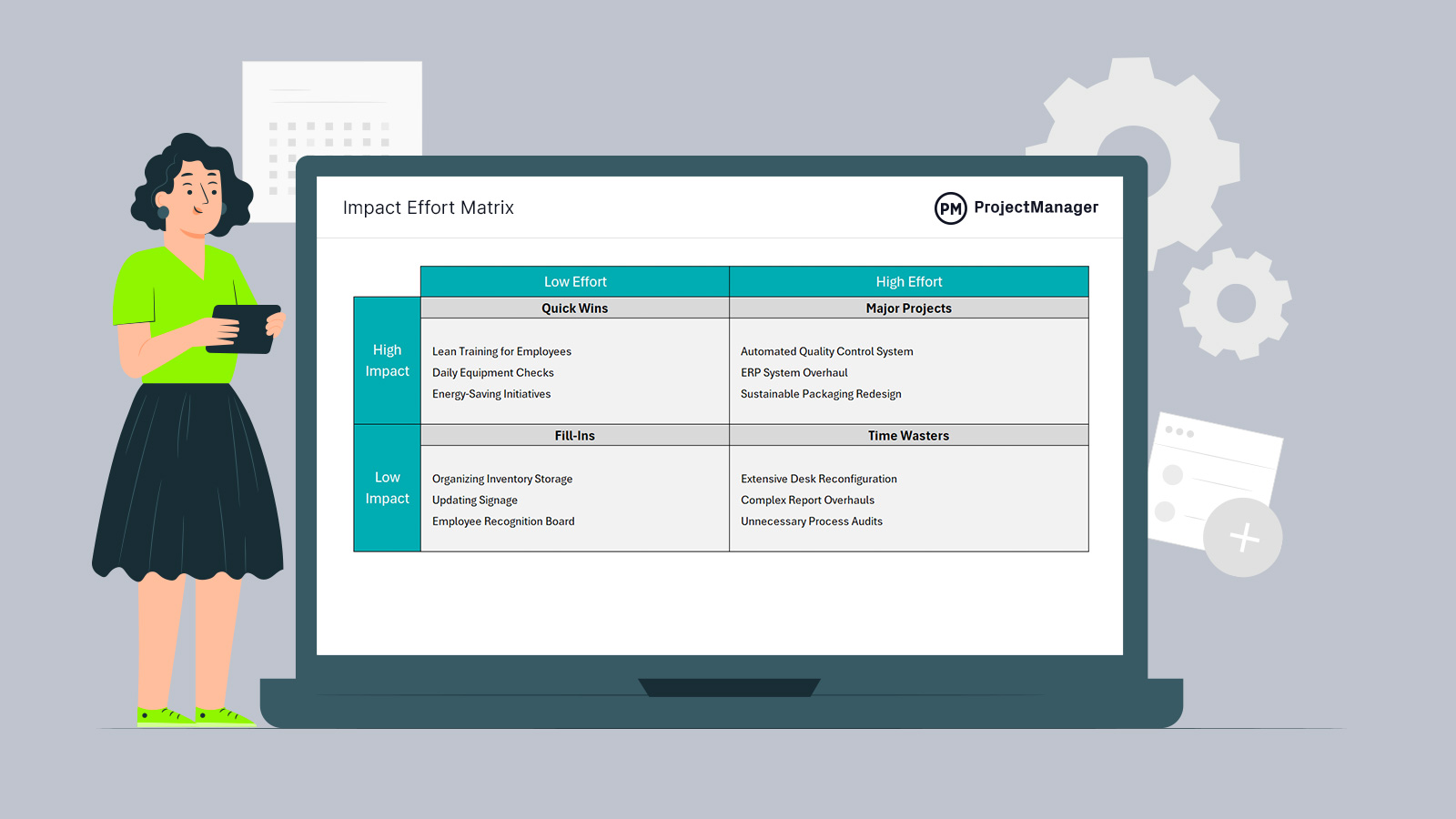
Get your free
Impact Effort Matrix Template
Use this free Impact Effort Matrix Template for Excel to manage your projects better.
The quadrants in an impact and effort matrix include quick wins, which are high impact and low effort and are tasks that are easy to implement and yield significant benefits. These should be prioritized. Major projects are high impact, high effort and are important initiatives that require substantial effort but can lead to great benefits. Plan and allocate resources strategically.
Other quadrants include fill-ins, which are low impact, low effort and are tasks that are easy to do but offer minimal benefits. These can be done when time allows. Time wasters are low impact, high effort and are tasks that require a lot of resources but provide little value. These should generally be avoided or minimized.
The impact effort matrix is only the starting point. After determining the priority of tasks, project managers have to assign those tasks to their teams. This is where project management software comes into play.
ProjectManager is award-winning project and portfolio management software that has multiple project views to plan and allocate resources to team members who have their choice of tools to execute them. Managers can plan resources and their associated costs on robust Gantt charts, which link all four types of task dependencies, filter for the critical path and set a baseline to track progress in real time. Teams can use the visual workflow of kanban boards to manage backlog or task lists to work on their tasks and update progress, while stakeholders can view the calendar view to get a monthly overview of work. Get started with ProjectManager today for free.
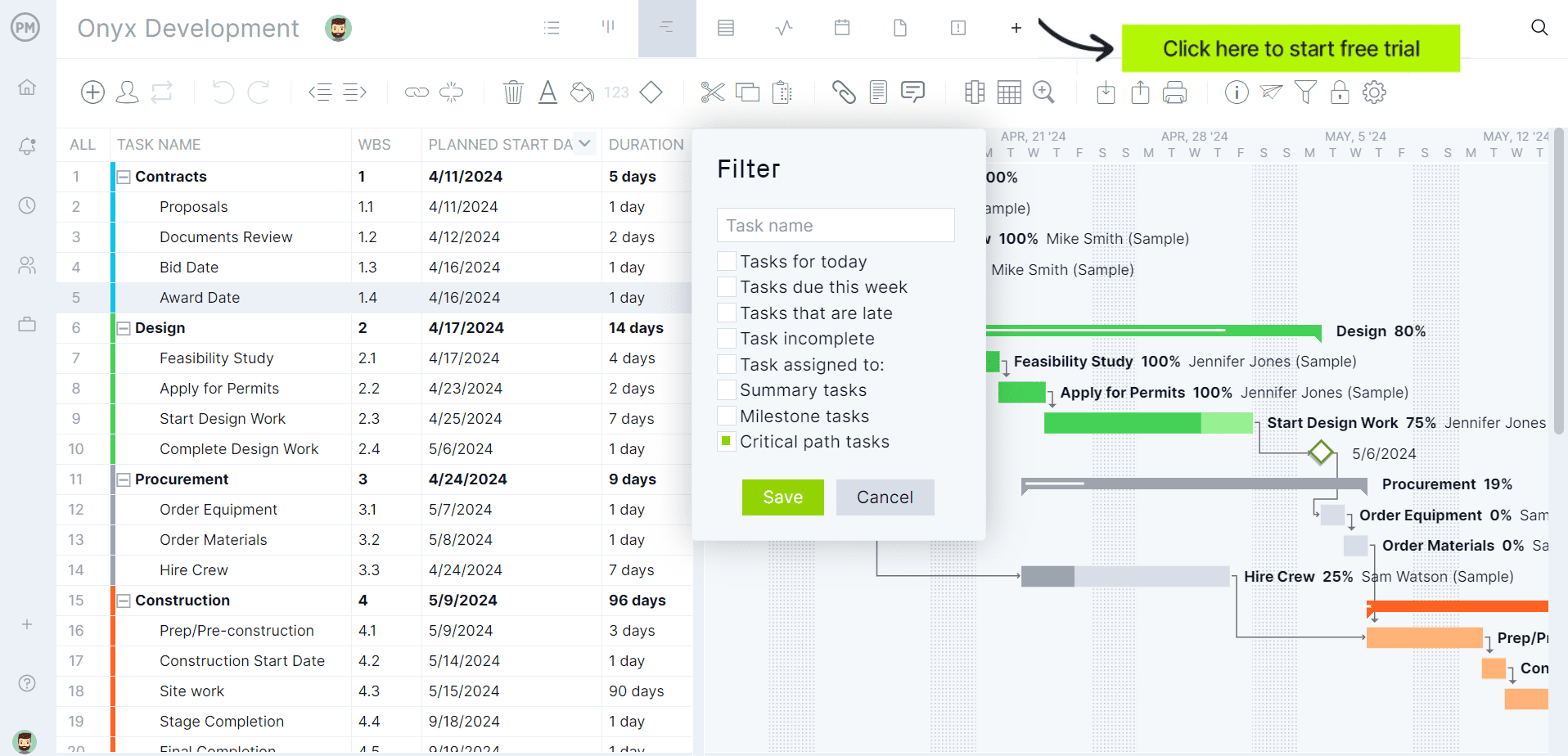
When to Use an Impact Effort Matrix
An impact and effort matrix is most useful when resources are limited and prioritization is essential for achieving optional results. The following are some of the specific scenarios when it can be applied.
- Project planning
- Backlog prioritization
- Resource allocation
- Strategic decision-making
- Process improvement
- Problem-solving
- Team alignment
Benefits of Using an Impact Effort Matrix
There are many benefits of using an effort impact matrix, from visualizing priorities and assisting in strategic decision-making to aiding in resource allocation and encouraging discussions on what to focus on. Here are some more reasons to consider using an impact and effort matrix.
Helps Establish Selection and Prioritization Criteria for Projects
Using an impact and effort matrix can significantly enhance the selection and prioritization criteria during the project intake process by providing a clear framework for evaluation. It also allows for the prioritization of resources by categorizing them into different quadrants. This facilitates decision-making, aligns team goals, identifies gaps and opportunities and supports continuous improvement.
Facilitates Workload Balancing and Non-Human Resource Allocation
An impact effort matrix helps balance workloads for nonhuman resources such as budget, tools or technology by identifying priorities into high and low impact based on their effort requirements, which helps allocate resources where they’ll have the most significant effect. This ensures that critical tasks don’t overwhelm available resources. It also helps visualize where resources can be applied more effectively. In terms of balancing workload across teams, the matrix facilitates discussions about workload, which helps managers redistribute tasks so no group is overwhelmed or underutilized. The matrix sets realistic expectations.
Informs the Project Budgeting Process
The matrix helps prioritize budget allocation as it identifies which projects or initiatives are high impact and low effort. This allows organizations to allocate budget resources to those that will yield the best returns. This prioritization ensures that funds are directed toward projects that align with strategic goals. It also helps estimate resource needs, balancing high and low-effort projects and justifying budget requests as well as allowing for ongoing budget review and tracking returns on investment.
Impact Effort Matrix Example
Let’s imagine that Acme Corp. is considering various projects. They use an impact effort matrix to help them decide which project is the best fit. Implementing a new lean training program and executing energy-saving initiatives fall under quick wins. Launching a new sustainable packaging redesign and doing an ERP system overhaul are major wins. Updating signage and organizing inventory storage are fill-ins. Finally, complex report overhauls and unnecessary process audits are time wasters.
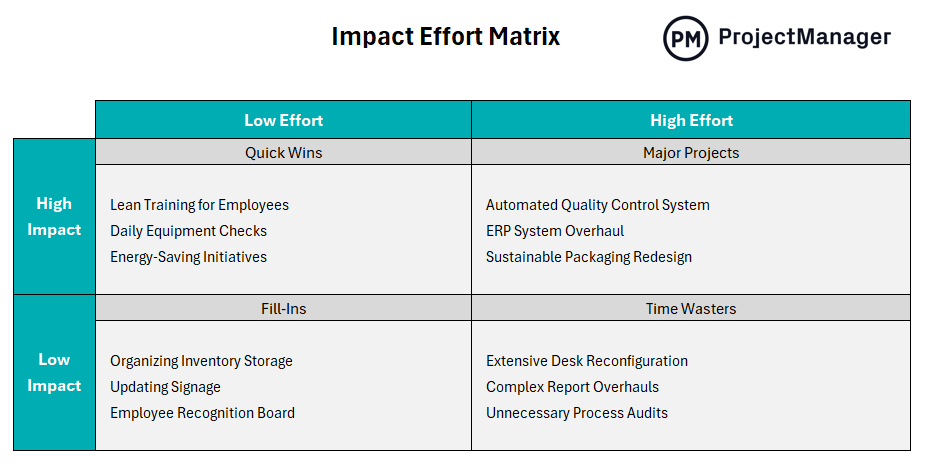
The projects in the portfolio that fall under quick wins should be prioritized for immediate action as they offer a high return on investment with relatively low resource expenditure. The major projects should be planned meticulously, with a clear strategy and budget in place. Stakeholders should ensure that the necessary resources are allocated to maximize success.
The tasks that fall under fill-ins should be scheduled as time allows, serving as fillers when teams have extra capacity or need morale boosts. The time wasters are projects that should be critically evaluated. Unless there’s a compelling reason to proceed, such as regulatory requirements, it’s generally better to avoid investing time and resources here.
Impact Effort Matrix Template
We’ll show how to create an impact and effort matrix next, but first here’s a link to download a free impact effort matrix template for Excel. It lays out everything that one needs to work out the prioritization or projects or tasks.
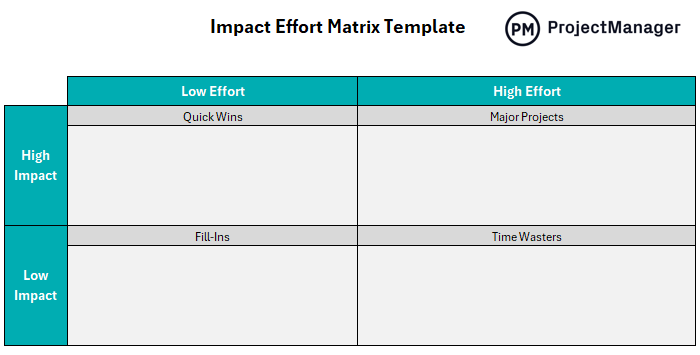
The free template is divided into the four quadrants of an impact effort matrix: quick wins, major projects, fill-ins and time wasters. The vertical axis goes from low impact to high impact, while the horizontal one is broken down into low effort and high effort. Following these distinctions will place projects or tasks in their appropriate place.
How to Make an Impact Effort Matrix
For those who want to build their own impact and effort matrix, follow the steps below.
1. Make a Task or Project List
Since this matrix can be used to prioritize tasks and projects, choose which to focus on and then make a task list. This list will then inform where the user places them on the matrix.
2. Impact Assessment
As noted in the matrix, the impact is one of the decision-makers. For this scenario, the impact can be either high or low. The impact criteria can be anything from increased revenue, customer satisfaction, productivity or other strategic objectives. Decide for each of the tasks or projects listed above.
3. Effort Assessment
Here, the effort is determined as either low or high. Factors that can influence the decision include time, resources, financial costs or complexity. While resources tend to be the main definition of effort, how long the work will take, the workforce or skill level required, the necessary budget to complete the work and its difficulty are also factored in.
4. Create the Matrix
Now, there is enough information to create the matrix and begin to fill it in. The first step is to create the axes, a vertical one with a row for low impact and another row for high impact. Then there is the horizontal axis, which consists of two columns, low effort and high effort. This creates four quadrants, which are titled as follows: high impact, low effort is a quick win, high impact, high effort is a major project, low impact, low effort is a fill-in and low impact, high effort is a time waster.
5. Place Tasks and Projects in Their Categories
With the matrix complete, use the task or project list created in the first step and place each item on that list in the appropriate quadrant. This completes the matrix.
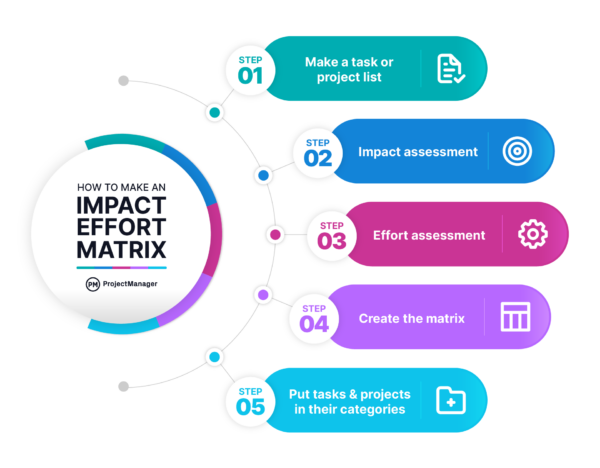
Related Resource Management Templates
The impact effort matrix template is only one of over 100 free project management templates for Excel and Word that can be downloaded immediately from our site. They cover all aspects of managing a project, across multiple industries. Below are a few templates that can help when managing resources on a project.
Decision Matrix Template
The decision matrix template for Excel is another visual tool that can be used to evaluate and prioritize a list of options more rationally. It works by determining a list of criteria that can influence a situation and then assigning a weighted value to each.
Resource Plan Template
A resource plan helps project managers to identify, list and organize resources that they’ll need to complete a project. This resource plan template for Excel helps to keep everyone informed about what they’re doing and when they’re doing it.
Workload Analysis Template
An impact effect matrix isn’t the only tool to help balance resource usage. This free workload analysis template for Excel helps to identify, measure and evaluate the amount of work that needs to be done by team members and balances their workload to keep them productive and avoid burnout.
How ProjectManager Helps with Project Resource Management
Free templates are tempting. Use them. But there will come a time when their limitations will create frustration. How can they not? They’re static documents that require manual updates and are poor collaborative tools. To clear the hurdles that templates place in front of working efficiently is easy, get project management software. ProjectManager is award-winning project and portfolio management software that can assign tasks to team members and allow them to use multiple project views to execute their tasks how they want. Those project views all update together in real time, giving managers transparency into resource utilization.
Track Team Work Hours with Workload Management Charts and Timesheets
When human resources are onboarded, managers can add their availability, such as PTO, vacation and global holidays, which makes it easier to assign them to tasks. Their skill sets can also be identified. Once they’re assigned, toggle over to the team page or the color-coded workload chart to monitor whether they’re overallocated or underutilized, then balance their workload to keep them working at capacity. Secure timesheets also provide a window into work hours as well as labor costs to help keep projects on budget.
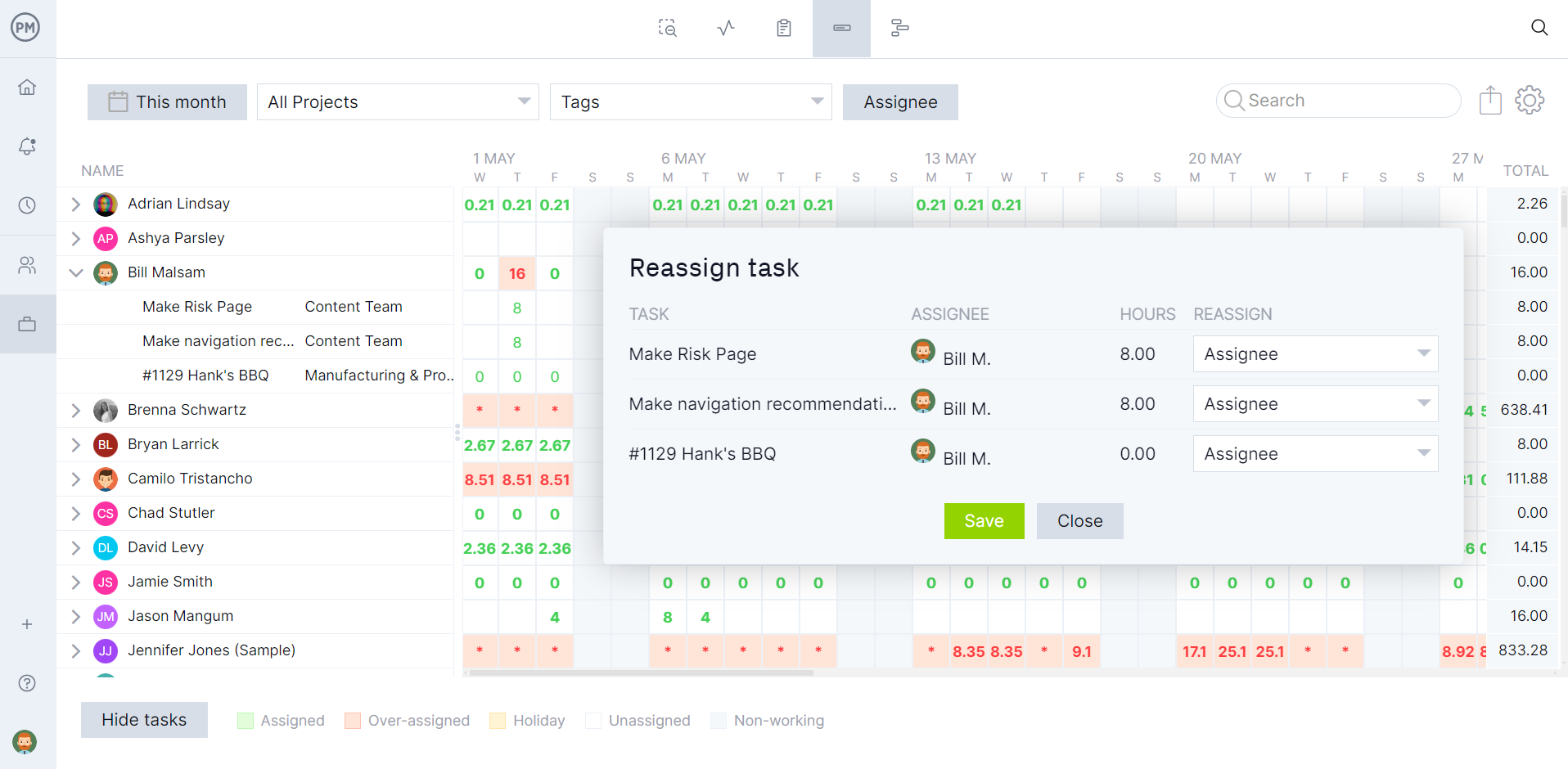
Monitor Projects Progress, Timelines and Costs with Real-Time Dashboards
Once a baseline is set on the Gantt chart, the project plan and schedule, including resources, are captured. Now, the plan can be compared against the actual effort in real time to track variance and keep the project on schedule. All managers have to do is use either the project or the portfolio dashboard for a high-level overview of time, cost, workload and more displayed on easy-to-read graphs and charts.
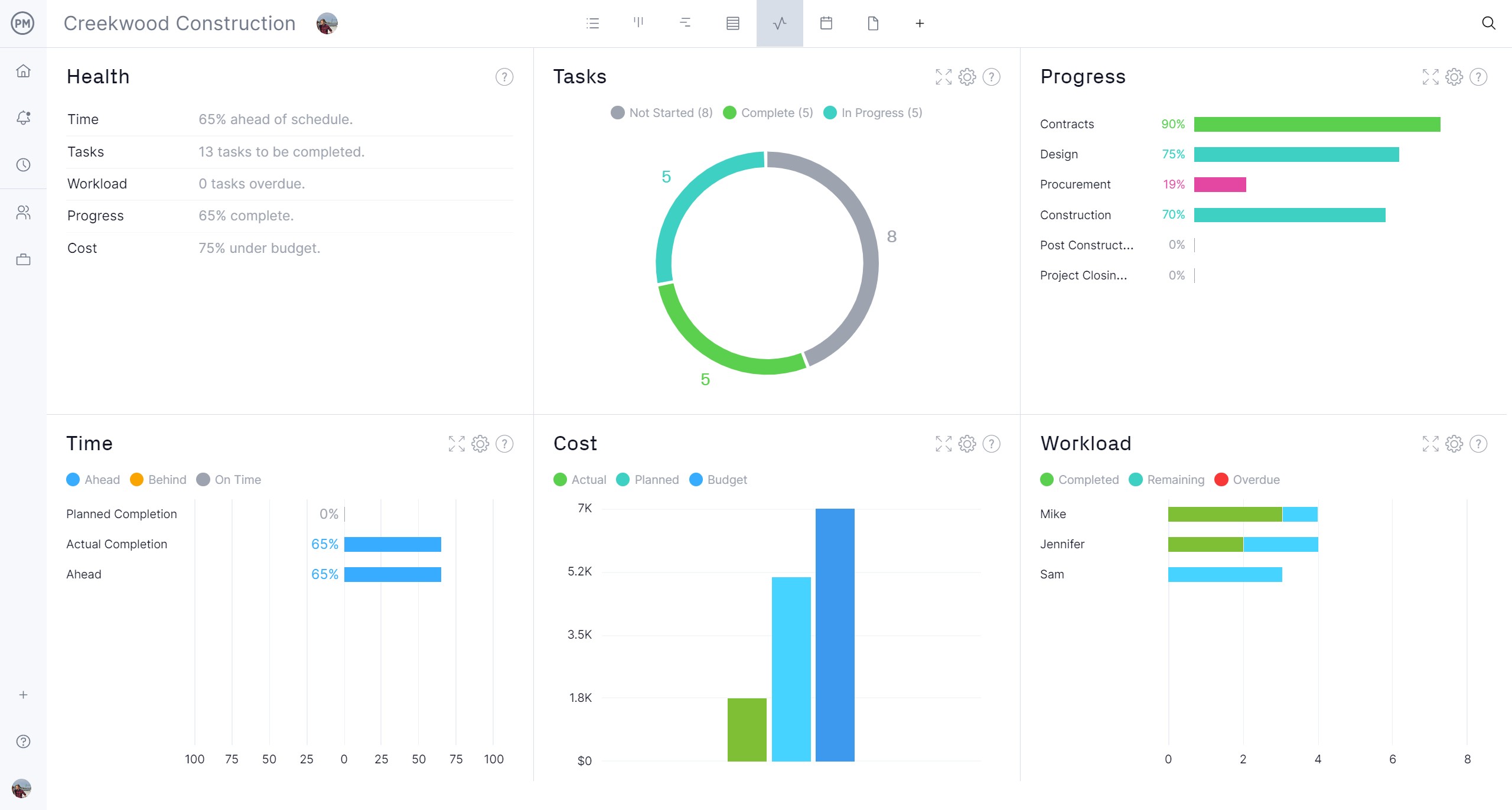
For more detail, use customizable reports for project status, portfolio status, variance, workload, timesheets and more. All reports can be filtered to go into the weeds for managers or capture a more general overview of progress that can be shared with stakeholders to keep them informed.
Related Content
There are many tools that managers and their teams can use to facilitate project management. This blog post on the impact effort matrix is only one or many. Below are some of the more recent posts we’ve published on the project intake process, cost-benefit analysis and more.
- Project Intake Process: Prioritizing Project Requests & Proposals
- Cost-Benefit Analysis: A Quick Guide with Examples
- Best Project Management Charts for Project Planning
- 20 Excel Spreadsheet Templates for Tracking Tasks, Costs and Time
- Capacity Planning: Strategies, Benefits and Best Practices
ProjectManager is online project and portfolio management software that connects teams whether they’re in the office, out in the field or anywhere else in the world. They can share files, comment at the task level and stay updated with email and in-app notifications. Join teams at Avis, Nestle and Siemens who use our software to deliver successful projects. Get started with ProjectManager today for free.

